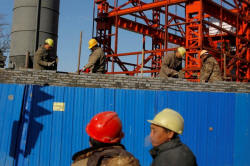China's 2017 GDP growth accelerates for first time in
seven years
 Send a link to a friend
Send a link to a friend
 [January 18, 2018]
By Kevin Yao and Elias Glenn [January 18, 2018]
By Kevin Yao and Elias Glenn
BEIJING (Reuters) - China's economy grew
faster than expected in the fourth quarter of 2017, as an export
recovery helped the country post its first annual acceleration in growth
in seven years, defying concerns that intensifying curbs on industry and
credit would hurt expansion.
The official growth figures released on Thursday are welcome news for
Beijing policymakers who are looking to cut debt and pollution in older
industries without stunting growth in the world's second-largest
economy.
China's gross domestic product grew 6.8 percent in the October to
December period from a year earlier. That was better than the 6.7
percent growth forecast by analysts in a Reuters poll and unchanged from
the previous quarter.
The headline numbers and signs of property market resilience support
economist views that fundamentals will remain intact in 2018, although
some see headwinds from tighter regulations, U.S. trade protectionism
and a softer consumer sector.

"China's growth is very healthy," said Iris Pang, a Hong Kong-based
Greater China economist at ING.
"The risks that we worried about in 2017, for example overcapacity cuts
having a negative impact on GDP, did not happen because new sectors are
actually coming out to help production to grow."
Growth for the 2017 full year picked up to 6.9 percent year-on-year, the
first annual acceleration for the economy since 2010. The annual growth
easily beat the government's 2017 target of around 6.5 percent and
quickened from 6.7 percent in 2016, the weakest pace in 26 years.
Investment by private firms rose 6 percent in the Jan-Dec period, up
from 5.7 percent growth in January to November, a sign that the private
sector outlook may be improving.
TRADE-BASED RECOVERY
A synchronized uptick in the global economy over the past year, driven
in part by a surge in demand for semiconductors and other technology
products, has been a boon to China and much of trade-dependent Asia,
with Chinese exports in 2017 growing at their quickest pace in four
years.
With fixed asset-investment growth at the weakest pace since 1999,
exports helped pick up the slack.
"Real growth of overall exports...more than fully (explained) the
pick-up in GDP growth last year," Oxford Economics head of Asia
economics Louis Kuijs wrote in a note.
But there could be rising headwinds to further expansion of China's net
exports this year.

China's excess production capacity has emerged as a major trade irritant
for the world's leading economic powers, prompting them to consider new
steps to protect domestic industries and jobs from a flood of Chinese
imports.
U.S. President Donald Trump's administration is considering several
unilateral tariff actions on steel, aluminum and China's intellectual
property practices likely to draw disputes from WTO members.
China's exports and imports growth slowed in December after surging in
the previous month.
[to top of second column] |

Workers lay bricks to build a wall around a construction site in
Beijing, China, December 15, 2017. REUTERS/Thomas Peter/File Photo

"Downside risks remain, in particular from more forceful U.S. trade restrictions
on Chinese exports, given the further increase in the U.S.'s bilateral trade
deficit with China last year," said Kuijs.
MIXED SIGNALS
Economists say growth momentum in the economy is likely to weaken this year as
firms face higher borrowing costs, the government tries to rein in credit and
policymakers step up a war on pollution that has hurt the industrial sector in
many parts of the country.
"The priority this year is to control risks, especially financial risks. This
will, to some extent, affect financing of the real economy. I think growth will
be 6.6 to 6.7 percent," said Wang Jun, chief economist at Zhongyuan Bank in
Beijing.
Retail sales growth of 9.4 percent was the slowest rate since February 2006,
down from 10.2 percent growth in November and badly missing forecasts.
There were some positive signs in the household sector in 2017, however, with
disposable income growth picking up to 7.3 percent from 6.3 percent in 2016, and
final consumption playing a bigger role in driving overall growth last year
versus investment than in 2016.
"The decline in December retail sales growth is mainly due to slowing auto sales
last month. The data is a reflection of consumption of physical goods, but right
now consumption growth is in services, which is not included in the data," said
Zhang Yiping, an economist at China Merchants Securities in Shenzhen.
"I donít think retail sales can reflect the trend in consumption any more."
DOUBTS ABOUT DATA
Several recent public revelations by regional governments of fraudulent
government data have again raised doubts about the quality of China's economic
numbers.

Chinese provinces and cities have long been suspected of cooking up numbers,
with the focus on local government officials, whose performance is often
assessed based on how well their respective economies have performed.
The head of China's statistics bureau Ning Jizhe told reporters on Thursday that
China will look into reports of irregularities in regional economic data, and
will deal with any impropriety according to the law.
Capital Economics senior China economist Julian Evans-Pritchard believes the
official numbers are hiding the true extent of some of the economy's soft spots.
"We think tight monetary conditions and slowing credit growth will continue to
weigh on the pace of economic expansion in coming quarters," Evans-Pritchard
said in a note.
"Indeed, we expect growth to average a mere 4.5 percent this year, though
investors will probably need to look beyond the official GDP figures for
evidence of this."
(Reporting by Kevin Yao and Stella Qiu; Writing by Elias Glenn; Editing by Sam
Holmes)
[© 2018 Thomson Reuters. All rights
reserved.] Copyright 2018 Reuters. All rights reserved. This material may not be published,
broadcast, rewritten or redistributed.
 |